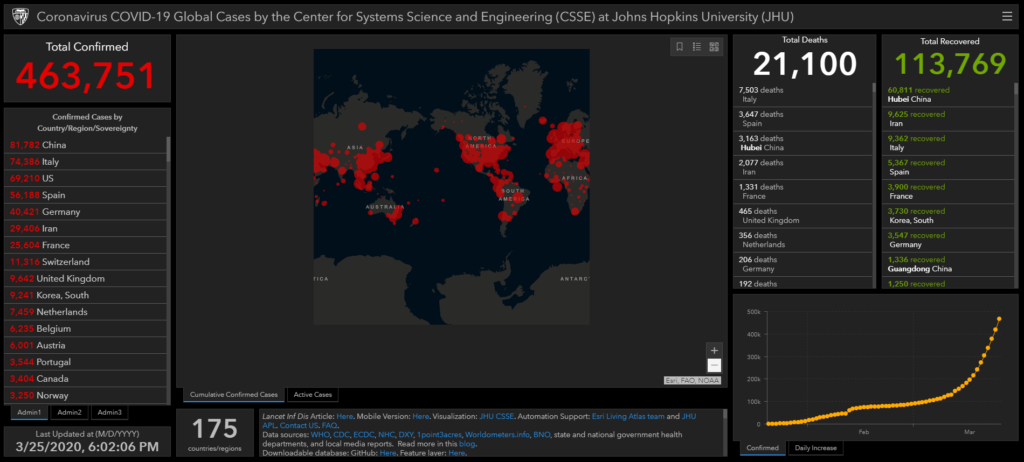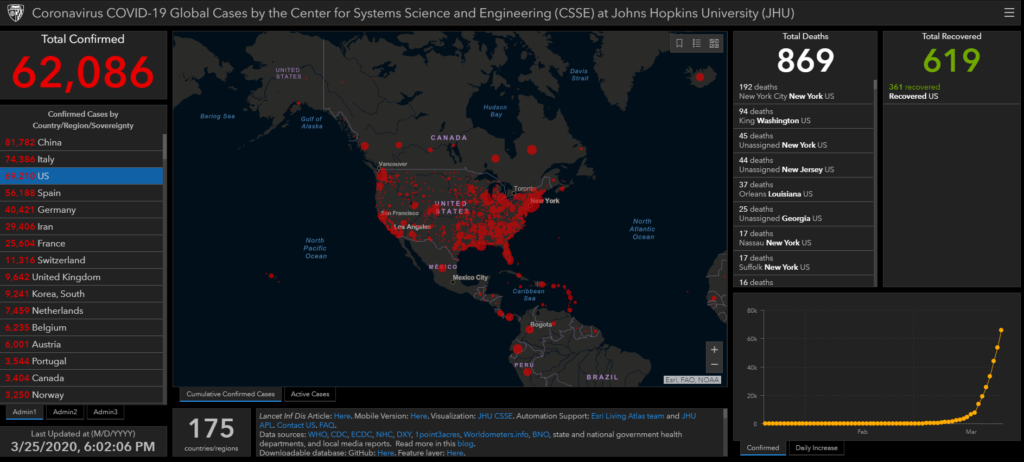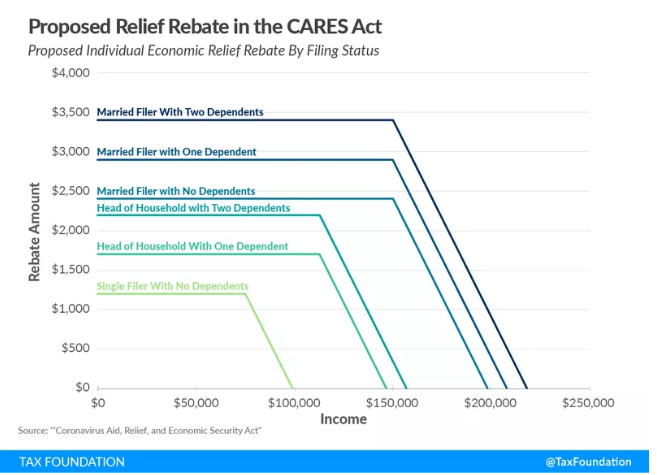

636: Number of confirmed cases in the state of North Carolina
12,910: Number of coronavirus tests conducted in the state
2: Number of deaths related to the coronavirus in North Carolina
17: Cases in Forsyth County; zero deaths
Winston-Salem will go into “stay at home” order beginning at 5 p.m. Friday. A full list of essential businesses, along with the full stay-at-home order can be found here. Mayor Allen Joines has ordered all residents to stay at home because of “a significant and increasing number of suspected cases of community transmission and likely further significant increases in transmission” of COVID-19. The stay-at-home order will last until April 16, or until modified.
The US death toll is actually a little higher than reflected here (which is current only to last night.
Over the past 24 hours, the U.S. reported 14,024 new cases of coronavirus and 265 new deaths, raising the total to 68,347 cases and 1,037 dead.
This is the highest number of new cases reported by a single country in one day since the coronavirus pandemic began.
Anyone who thinks we’re going to be over this in a couple more weeks is insane.
After a week of Congress members and the Trump administration proposing various plans to get cash into the hands of Americans to help them weather the coronavirus crisis, the Senate has unanimously passed a plan.
The “phase three” coronavirus bill, includes, as of now, cash measures totaling $290 billion per the Center for a Responsible Federal Budget.
The plan’s provisions are very simple. Adults would get $1,200 each and children $500 each. At higher incomes, the checks would get smaller: The benefit would start decreasing at a rate of $5 for every additional $100 in income. The phaseout starts at $75,000 in adjusted gross income for singles, $112,500 for heads of household, and $150,000 for married couples filing jointly; it would phase out entirely by $99,000 for singles and $198,000 for couples (with no children).
For example, a single childless person with an AGI of $85,000 would get $700 because $500 of the benefit was phased out by their higher income.
Unlike some early Senate Republican proposals, there is no minimum income (which would’ve excluded very poor people), and the check amounts don’t “phase in,” so the middle class doesn’t get more than the poor.
Here is how that policy looks in graph form:

Other factors of the relief:
A $500 billion loan program for businesses: The biggest sticking point between Democrats and Republicans throughout the negotiations was $500 billion in emergency loans both for large businesses and municipalities grappling with the coronavirus outbreak. For instance, $50 billion of that money was allotted to passenger airlines, according to the Washington Post.
Rather than trying to negotiate that figure down, Democrats instead negotiated to have strings attached to it. Instead of giving the Trump administration broad discretion to make the loans, Schumer and Pelosi said there will likely be a new inspector general in the Treasury Department specifically to oversee these funds, as well as a congressional oversight panel to examine how the money is being used. Schumer’s office also announced they secured a provision that will “prohibit businesses controlled by the President, Vice President, Members of Congress, and heads of Executive Departments from receiving loans or investments from Treasury programs.” The children, spouses or in-laws of lawmakers and executive officials also cannot receive these loans.
Some additional conditions, championed by progressives and supported by the public, including a requirement for companies to implement a $15 minimum wage, have not made it into the final legislation.
“Unemployment insurance on steroids”: Schumer announced Monday afternoon that unemployment insurance will be expanded to grapple with a new surge in claims, calling it “unemployment insurance on steroids.” The new bill will increase unemployment insurance by $600 per week for four months. This money is in addition to what states pay as a base unemployment salary. This benefit would extend to gig economy workers, freelancers, and furloughed workers who are still getting health insurance from their employers, but are not receiving a paycheck.
Expanded funds for hospitals, medical equipment, and health care worker protections: The bill contains $150 billion to boost the health care system, according to Schumer. Of that money, $100 billion will go to hospitals, $1 billion will go to the Indian Health Service, and the remainder will be used to increase medical equipment capacity.
Increased aid to state and local governments: Schumer also said about $150 billion of federal money would be allocated for state and local governments who are dealing with the impacts of the crisis in their local communities, including $8 billion for tribal governments.
Direct payments to adults below a certain income threshold: The legislation includes a one-time $1,200 check that would be sent to most adults making $75,000 or less annually, according to past tax returns. A $500 payment would also be sent to cover every child in qualifying households. The final policy marks a significant change from the direct payments initially proposed by Republicans, which would have given less to many individuals who do not have taxable income. It now includes the majority of adults who are under the $75,000 threshold and phases the payment out as people’s incomes increase.
Loans to small businesses: There is $367 billion in the bill aimed at providing loans for small businesses, according to the Washington Post.
The US Department of Labor registered nearly 3.3 million initial unemployment insurance claims last week, according to data newly reported this morning.
That shatters the previous record, which was about 700,000 in seasonally adjusted terms, or a million in raw terms, way back in 1982. Just a few days ago, a Goldman Sachs analysis predicting 2.25 million initial claims was seen as an alarming forecast. The real figure was much higher — pretty much literally off the charts.

Here’s the NC graph:

And the news, to be clear, is in many ways even worse than that sounds. This is data released on the morning of March 26, but it covers the period that ended on March 21. Total or partial shutdowns of non-essential business activity have spread considerably since five days ago, so we should expect next week’s report to feature further devastation. And that’s to say nothing of the secondary consequences of people losing jobs and incomes to Covid-19 and thus being forced to curtail spending.
The medical news grows grimmer everyday, especially at the front lines.
The NY Times and CNN’s Brynn Gingras both delivered reports on Elmhurst Hospital Center in Queens, which has transferred non-coronavirus patients to other facilities in order to become one of the city’s main crisis centers. Medical officials have spoken of an “apocalyptic” scene inside the hospital, describing how they’re forced to work with increasingly strained resources as patients are dying while in wait at the emergency room.
“We’re busting at the seams essentially. Every bed is basically filled,” Gingras said, quoting a hospital worker. “The hospital is already having to take measures transferring patients to other hospitals because they can’t keep up with the demand. They’re having to bring in more doctors and nurses, more equipment daily just to keep up with this demand. It’s not sustainable, quite frankly, is what we’re hearing.”
Between treating patients and dealing with crowds of people who are sick or looking to be tested, reports also highlighted how refrigerated trucks have been brought in to serve as makeshift morgues for the bodies of deceased patients. CNN’s report also alluded to how the situation is compelling medical professionals to have new conversations to decide on who they can try to save.
“The fact that we’re having this conversation about people’s [do not resuscitate] decisions is staggering,” said Dr. Jeanne Marrazzo. “If it’s not a wake-up call to people, I don’t know what else can be.”
Trump is still hoping to have the economy roaring back by Easter. But at yeseterday’s briefing (after Trump left the stage), coronavirus task force member Dr. Anthony Fauci warned that the coronavirus “very well might” become a seasonal cycle. “It will be inevitable that we need to be prepared that we will get a cycle around,” Fauci said. Fauci is the director of the National Institute of Allergy and Infectious Diseases.
Fauci explained that the possibility of the coronavirus coming back in “cycles” means that “it emphasizes the need to do what we are doing,” referring to the administration’s efforts in developing a vaccine as quickly as possible so that it will be available “for that next cycle.”
On CNN he told Chris Cuomo: “You’ve got to be realistic and you’ve got to understand that you don’t make the timeline. The virus makes the timeline.”
Other bits:
Trump on delaying the Olympics: "It's probably the first time maybe ever or certainly in a long time that it was on an odd year. It's always on an even year, they tell me."
— Kyle Griffin (@kylegriffin1) March 25, 2020
NBC and CNN producers say they’re through airing Trump’s virus pressers. “We might take it from the top and then cut away after the first lie, and return when the lies stop.”
Here is the playbook which Trump ignored:
